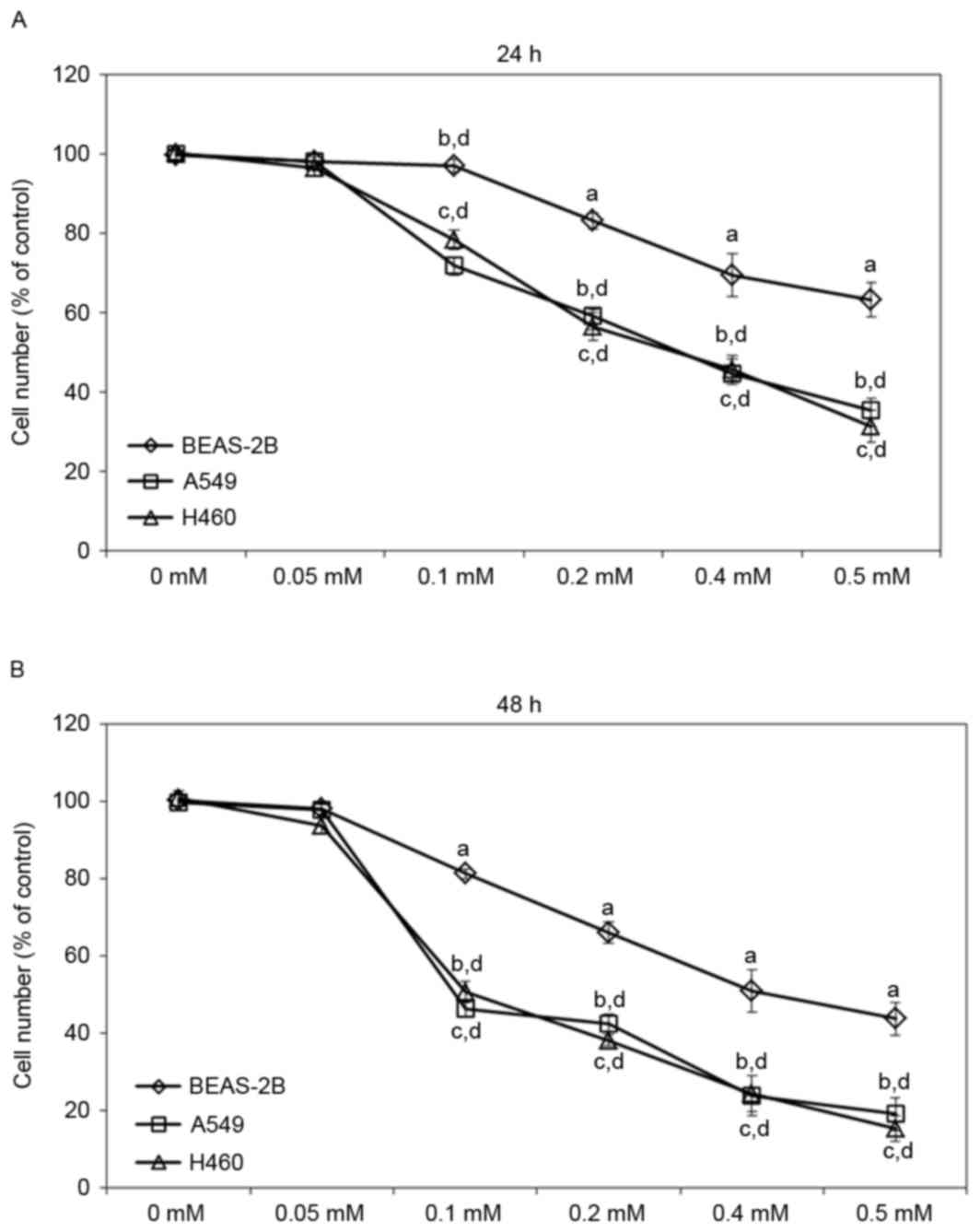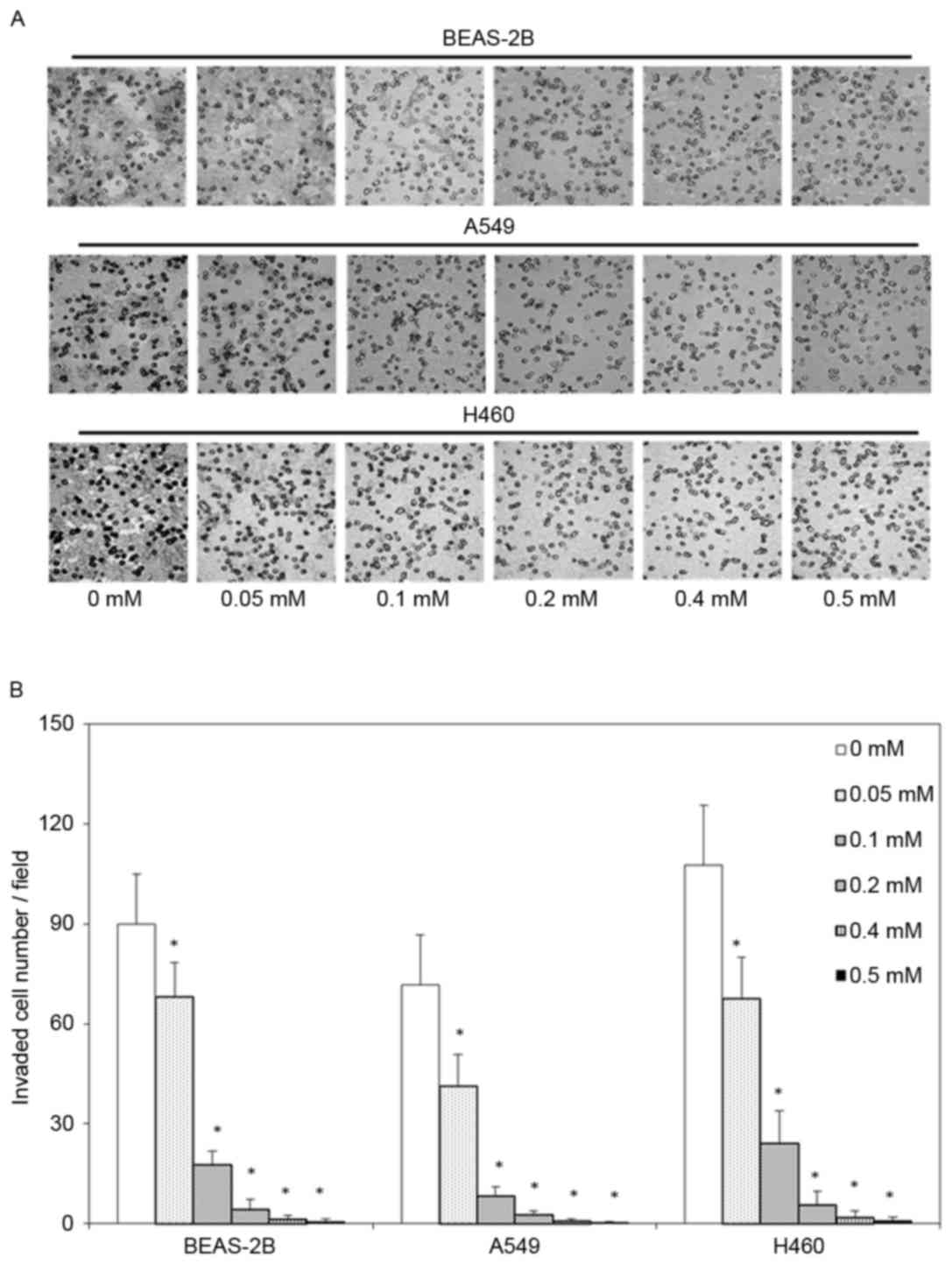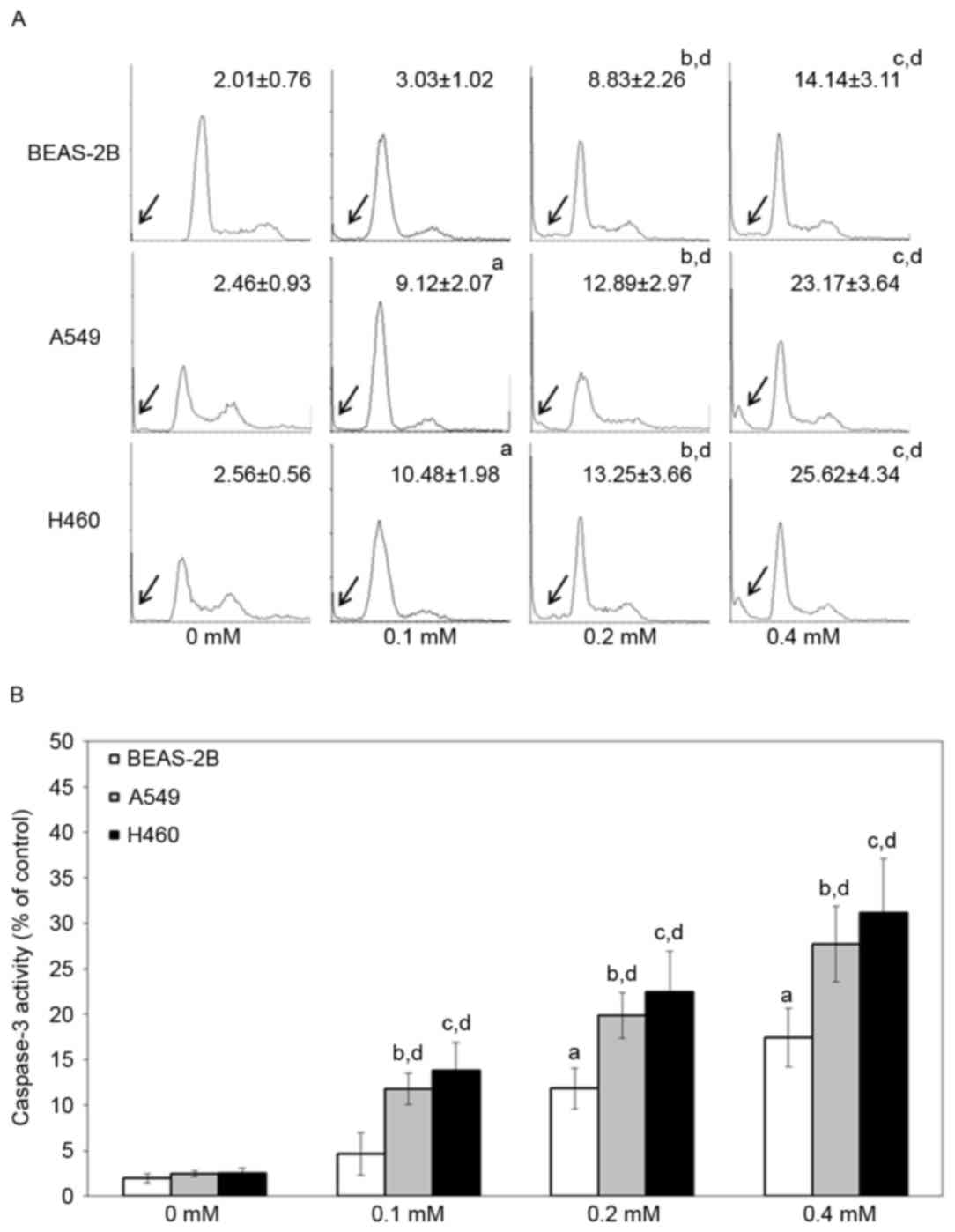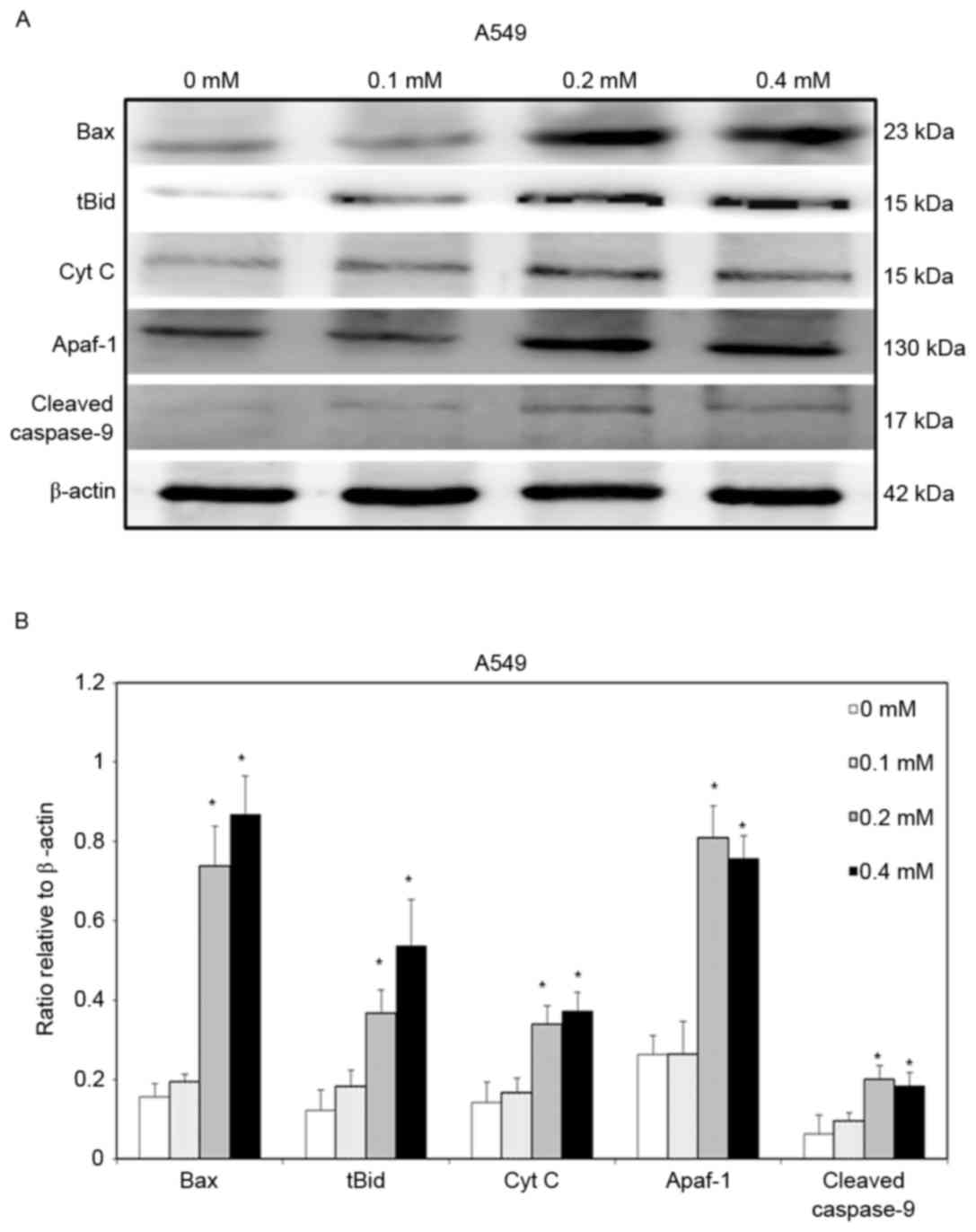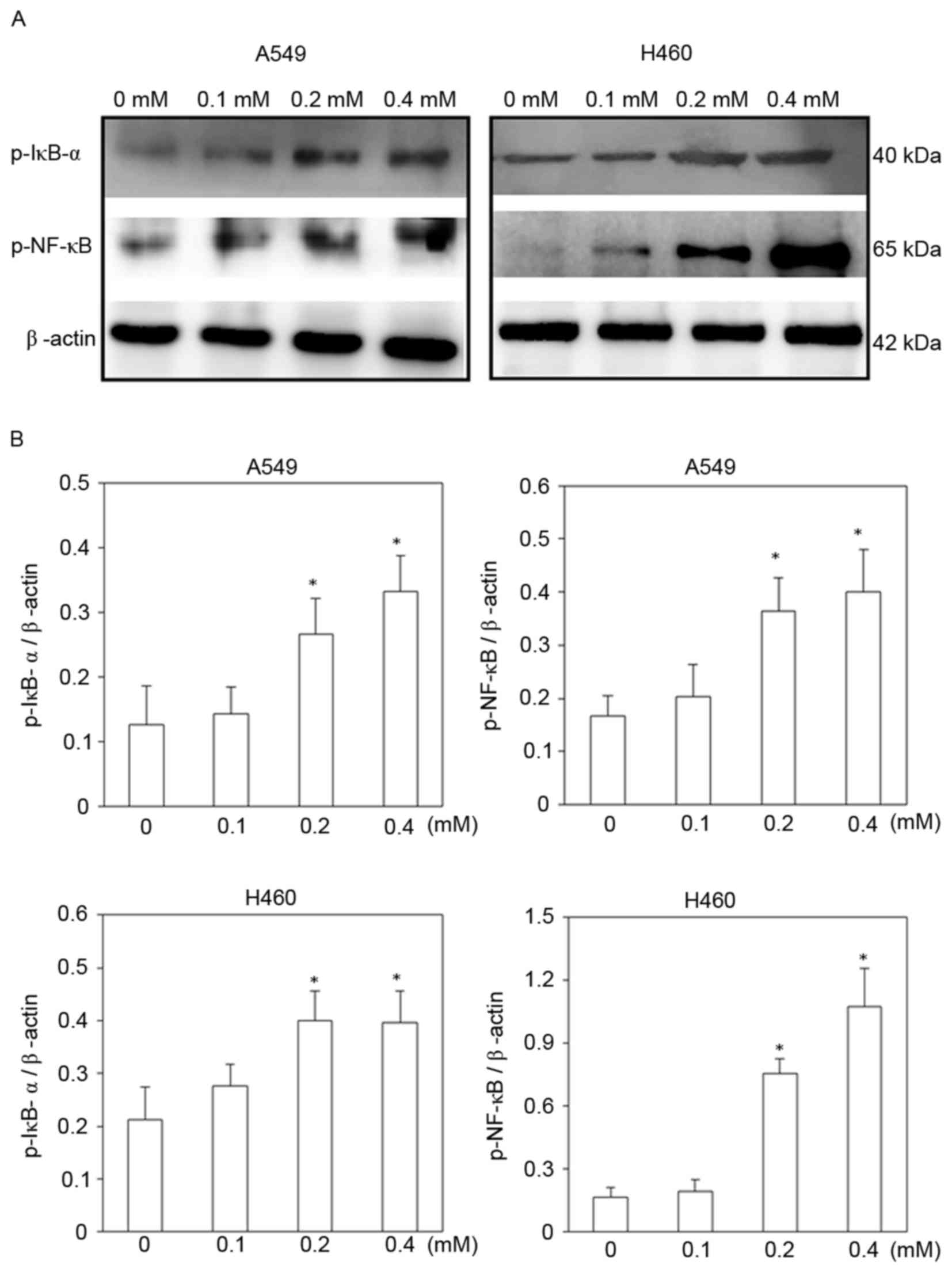Escitalopram oxalate inhibits proliferation and migration and induces apoptosis in non-small cell lung cancer cells
- Authors:
- Published online on: December 21, 2017 https://doi.org/10.3892/ol.2017.7687
- Pages: 3376-3382
Abstract
Introduction
Many statistical reports indicated that malignant tumors that are associated with lung cancer are the leading cause of death globally (1,2). Based on its biological characteristics and clinical manifestations, lung cancer can be classified into small cell lung cancer (SCLC) and non-small cell lung cancer (NSCLC) (3). Small-cell lung tumors undergo metastasis more rapidly than NSCLC to other organs, such as the brain, skeleton, and lymph tissues (4). NSCLC can be divided into adenocarcinoma, squamous cell carcinoma, and large cell carcinoma. Large cell carcinoma is the most difficult to treat owing to its potential presence in any part of the lungs as well as its rapid growth and migration (5).
Antidepressants are frequently dispensed to cancer patients who are suffering from depressive disorders that develop in later stages. A population-based cohort study found that neuroleptic medications are associated with a reduced cancer risk (6), including a reduced lung cancer (7). An increasing number of retrospective studies are finding that selective serotonin reuptake inhibitors (SSRIs) have an anti-proliferative or cytotoxic effect on various cancers (8). Fluoxetine, a commonly used SSRI, has been demonstrated to slow the cell cycle progression in A549 cells by reducing cyclin D1 and cyclin A expressions and inducing P53 and P21 protein expressions (9). These findings reveal that antidepressants such as SSRIs may have therapeutic potential against NSCLC.
Escitalopram oxalate, also known as Cipralex® (H. Lundbeck A/S, Copenhagen, Denmark) and Lexapro® (Forest Laboratories, Inc., St. Louis, MO, USA), is a SSRI that is used for the treatment of major depressive disorder (MDD) and anxiety disorder by selectively binding to the human serotonin transporter (10). Based on a meta-analysis and a pooled analysis, escitalopram oxalate is more effective than other antidepressants (11). The relevant results indicated that escitalopram oxalate was superior to a placebo, and almost as effective as, or superior to, other SSRIs, including citalopram, paroxetine, fluoxetine and sertraline, and serotonin-noradrenaline reuptake inhibitors, including duloxetine and sustained-release venlafaxine. Escitalopram oxalate also exhibits favorable tolerability and causes generally mild and temporary adverse events (11). Since few studies of reports on the effects of escitalopram oxalate in NSCLC cells have been published, the present study attempts to examine the effects of escitalopram oxalate on NSCLC and the underlying mechanism involved.
Materials and methods
Cell line and escitalopram oxalate
NSCLC cell lines, A549 and H460, purchased from Taiwan Food Industry Development Research Institute (Hsinchu, Taiwan) were cultured in RPMI-1640 medium containing 5% FBS (Gibco; Life Technologies Co., Grand Island, NY, USA). Human bronchus epithelial cell line BEAS-2B, kindly provided by Dr Gow-Tarng Sheu (Graduate Institute of Medicine, Chung Shan Medical University, Taichung, Taiwan) was cultured in RPMI-1640 medium containing 10% FBS as control cell line. The SSRI, escitalopram oxalate (Lexapro; Sigma, St. Louis, MO, USA), was provided by Chiayi Chang Gung Memorial Hospital.
MTT assay
A total of 5×103 cells was seeded in each well of a 96-well plate and cultured overnight for cell adhesion. The culture medium was then removed and replaced with medium containing different concentrations of escitalopram oxalate. Triplicate treatments were conducted for each concentration. After incubation with different concentrations of escitalopram oxalate for 24 or 48 h, the culture medium was removed and 0.2 ml MTT reagent (0.5 mg/ml) was added to each well for another 2 h. A 0.2 ml DMSO was then added to each well of the plate to dissolve the crystal and absorbance was measured at 570 nm with an ELISA reader. The relative cell survival rate was calculated based on the ratio of the absorbance of the sample treatment relative to the absorbance of the control treatment.
Cell-migration assay
To measure the effects of escitalopram oxalate, a modified Boyden chamber assay using cell culture inserts with a 12-µm pore size polycarbonate filter in a 48-well format was used to perform an in vitro migration assay. Cells were seeded on the upper part of the chamber at a density of 2×104 cells/well in 50 µl of serum free medium. For the invasion assay, 10 µl Matrigel (BD Biosciences, Bedford, MA, USA) was applied to 12-µm-pore size polycarbonate membrane filters, with the bottom chamber of the apparatus containing standard medium and then incubated for 16 h at 37°C. The cells that had invaded to the lower surface of the membrane were fixed with methanol, washed with dd-H2O, and then stained with Giemsa. Ten random fields were counted for each experiment under a light microscope at ×200 magnification per filter.
Flow cytometric analysis
A total number of 2×106 cells per 100 mm2 were seeded in culture plates for 24 h at 37°C in a 5% CO2 incubator. The cells were then incubated with various concentrations of escitalopram oxalate for 24 h. After incubation, the cells were harvested, washed with PBS, and fixed with 70% alcohol for 16 h at 4°C. The cells were then washed using PBS and transferred into 12×75 mm tubes. A total of 10 µl of propidium iodide (PI) staining solution was added to each tube, and the contents were gently mixed. The mixture was incubated in an ice bath in the dark. Following filtration through a 40 µm nylon screen, the stained cells were analyzed using a FACSCalibur analyzer (Becton Dickinson, Bedford, MA, USA).
Caspase-3 activity assay
Analysis of caspase-3 activity was performed in triplicate using the caspase-3, active form, ELISA pair kit (BD Biosciences, San Diego, CA, USA) according to the manufacturer's protocol.
Protein extraction and western blotting
Cell lysates were obtained by homogenizing the cells in lysis buffer (20 mM Tris-HCl, 150 mM NaCl, 1 mM Na2EDTA, 1 mM EGTA, 1% Triton X-100, 2.5 mM sodium pyrophosphate, 1 mM β-glycerophosphate, 1 mM Na3VO4 and 1 µg/ml leupeptin). The homogenates were then centrifuged at 12,000 × g for 40 min and the supernatants were collected and stored at −80°C for further experiments. Western blotting was performed as described elsewhere (12). Protein samples were denatured for 10 min in boiling water with sample buffer (0.0625 M Tris-HCl buffer, pH 6.8, containing 2.3% SDS, 5% 2-mercaptoethanol, and 10% glycerol). Samples were applied to a 12.5% Sodium dodecyl sulfate-polyacrylamide gel (SDS-PAGE) and electrophoresis at 100–150 V for 1.5 h and then electrophoretically transferred to a nitrocellulose membrane (Amersham Biosciences, Piscataway, NJ, USA). The membrane was then soaked in PBS with 5% nonfat dry milk for 30 min at room temperature. Antibodies against Bax, tBid, cytochrome c, Apaf-1, cleaved caspase-9, phosphorylated IκB-α (p-IκB-α) and NF-κB (p-p65) and β-actin (Upstates, Charlottesville, VA, USA; Santa Cruz Biotechnology, Santa Cruz, CA, USA) were diluted in PBS with 2.5% BSA and incubated for 1.5 h with gentle agitation at room temperature. The membranes were washed twice with PBS-Tween for 1 h, and a secondary antibody conjugated with horseradish peroxidase (HRP) was added. Pierce's SuperSignal West Dura HRP Detection kit (Pierce Biotechnology Inc., Rockford, IL, USA) was used to detect antigen-antibody complexes. The blots were scanned and quantified by densitometry (Appraise, Beckman-Coulter, Brea, CA, USA).
Statistical analysis
All statistical analyses were performed using SPSS 10.0 software (SPSS Inc., Chicago, IL, USA). Three independent experiments were repeated. Statistical analyses were performed using the analysis of variance plus posterior multiple comparison test to determine the difference. P<0.05 was considered statistically significant. The significant differences were stressed with symbols as shown in figures.
Results
Escitalopram oxalate attenuates proliferation and invasive ability in A549 and H460 cells
To evaluate the effects of escitalopram oxalate on NSCLC, A549 and H460 cell lines were treated with various concentrations of escitalopram oxalate. Treatment with 0.1, 0.2, 0.4 or 0.5 mM escitalopram oxalate for 24 h significantly reduced the viability of both A549 and H460 cells relative to those in the control group and the control cell line, BEAS-2B, respectively (Fig. 1A). Significantly reduced cell viability was also detected in A549 and H460 cells that were treated with 0.1, 0.2, 0.4 or 0.5 mM escitalopram oxalate for 48 h relative to those in the control group and the control cell line, BEAS-2B, respectively (Fig. 1B). Moreover, the invasive ability of BEAS-2B, A549 and H460 cells was evaluated as the number of cells that passed through a polycarbonate filter with 12 µm pores, the number of invaded in BEAS-2B, A549 and H460 cells that were treated with 0.05, 0.1, 0.2, 0.4 or 0.5 mM escitalopram oxalate for 24 h cells was significantly smaller than the corresponding number in the control group (Fig. 2).
Escitalopram oxalate increases sub-G1 population and induces apoptosis in A549 and H460 cells
To study the cell death pathway that is involved, BEAS-2B, A549 and H460 cells were treated with various concentrations of escitalopram oxalate for 24 h and examined by flow cytometry with PI staining and caspase-3 activity assay. Significantly increased sub-G1 proportions were detected in both A549 and H460 cells that had been treated with 0.1, 0.2 and 0.4 mM escitalopram oxalate, relative to those in the control group or the control cell line, BEAS-2B (Fig. 3A). Significantly increased caspase-3 activities were detected in both A549 and H460 cells that had been treated with 0.1, 0.2 and 0.4 mM escitalopram oxalate, relative to cells in the control group or the control cell line, BEAS-2B (Fig. 3B). Since significantly increased sub-G1 and caspase-3 activity were detected in A549 and H460 cells, relative to BEAS-2B cells, the following experiments were performed on A549 and H460 cells.
Escitalopram oxalate-induced mitochondrial dependent apoptosis in A549 and H460 cells
To clarify further the signaling that is involved in escitalopram oxalate-induced apoptosis in both A549 and H460 cells, the expressions of Bax, tBid, cytochrome c, Apaf-1 and cleaved caspase-9 proteins were detected. Significant increases in levels of Bax and tBid proteins were detected in A549 cells that were treated with 0.2 and 0.4 mM escitalopram oxalate for 24 h relative to those in the control group (Fig. 4). Thersefore, significant increases in cytochrome c and Apaf-1 were detected in A549 cells that were treated with 0.2 and 0.4 mM escitalopram oxalate for 24 h, relative to those in the control group (Fig. 4). Furthermore, cleaved caspase-9, the level of a downstream molecule of Apaf-1, was significantly increased in A549 cells that were treated with 0.2 and 0.4 mM escitalopram oxalate for 24 h, relative to those in the control group (Fig. 4). Similar results were observed for H460 cells. Significantly increased Bax, tBid, cytochrome c, Apaf-1 and cleaved caspase-9 protein levels were detected in H460 cells that had been treated with 0.2 and 0.4 mM escitalopram oxalate for 24 h, relative to those in the control group (Fig. 5).
Signaling molecules involved in the escitalopram oxalate induced-apoptosis in A549 and H460 cells
To identify signaling pathways that may be involved in escitalopram oxalate-induced apoptosis in A549 and H460 cells, the expressions of p-IκB-α and NF-κB (p65-p) proteins were examined. The expressions of both p-IκB-α and NF-κB (p65-p) proteins were significantly increased in both A549 and H460 cells following treatment with 0.2 and 0.4 mM escitalopram oxalate for 24 h, relative to those in the control group (Fig. 6). Significantly increased p-IκB-α and NF-κB (p65-p) protein levels were also detected in H460 cells that had been treated with at 0.2 and 0.4 mM escitalopram oxalate for 24 h, relative to those in the control group (Fig. 6).
Discussion
Neuroleptic medications are reportedly associated with a reduced risk of certain cancers. However, relatively little is known about the mechanism by which SSRI causes NSCLC cell death. This study demonstrated that escitalopram oxalate, a more effective SSRI, has significantly inhibitory effects on the proliferation and invasive ability of A549 and H460 cells, relative to the controls. Escitalopram oxalate also caused significant apoptosis by inducing mitochondria-associated cascades in both A549 and H460 cells. These findings suggest that escitalopram oxalate may have therapeutic potential against NSCLC.
Cell migration is known to involve a complex mechanism. It is required for many biological activities, including embryogenesis, wound healing, immune response and tissue repair (13). Errors in the cell migration process cause serious pathologic episodes, including cancer invasion and metastasis (14,15), which are important characteristics of malignant tumor cells (16). Cancer metastasis comprises four essential steps, including detachment, migration, invasion and adhesion, which are different but interrelated (17,18). Once cancer cells have spread beyond their initial primary site, the cancer is typically incurable and fatal (19). Cancer metastasis is the leading cause of morbidity and mortality, and is responsible for almost 90% of all cancer mortality (20). Therefore, constraining cancer metastasis is important in cancer therapy. In this study, escitalopram oxalate significantly reduced the motility and invasive abilities of A549 and H460 cells, exhibiting a potential to inhibit the migration of NSCLC cells.
Unlimited proliferation is known to be a critical process in cell carcinogenesis. Therefore, compounds that suppress tumor growth by inducing cell cycle arrest and apoptosis are favored for cancer therapy (21,22). The induction of apoptosis is one of the main mechanisms for impeding cancer growth and is regarded as necessary for screening novel anti-cancer agents (23). The mechanisms of apoptosis are highly complex and sophisticated. The two main pathways of apoptosis are extrinsic and intrinsic, which are linked with each other (24). The extrinsic signaling pathways that initiate apoptosis involve transmembrane receptor-mediated interactions, such as the engagement of tumor necrosis factor (TNF) and TNF receptor (25). The intrinsic signaling pathways that induce apoptosis involve intracellular signals that act directly on targets in the cell and are mitochondria-initiated events. The events involve cytochrome c, which activates the caspase-dependent mitochondrial pathway. Cytochrome c binds and activates Apaf-1 and procaspase-9, forming an ‘apoptosome’ (26). The clustering of procaspase-9 in this manner eventually results in caspase-9 and caspase-3 activation (27). In this study, the cytotoxic activity of escitalopram oxalate was triggered by releasing Bax, tBid, cytochrome c and Apaf-1, resulting in the proteolytic cleavage of caspase-9 and caspase-3 in A549 and H460 cells. These findings suggest that the therapeutic efficacy of escitalopram oxalate against NSCLC cells involves inducing mitochondria-dependent apoptosis. However, other possible mechanisms and interactive targets that are involved in escitalopram oxalate-induced cell death in NSCLC cells warrant further investigation.
Evidence reveals that neuroleptic medications are associated with a reduced cancer risk (6,28). Various SSRIs, especially fluoxetine, are known to reduce the risk of cancer (29–31), including lung cancer (9). However, the side-effects of fluoxetine remain problematic (32). Escitalopram oxalate is a superior SSRI that has been demonstrated to have favorable tolerability and to cause generally milder and more temporary adverse events than other SSRIs (11). The present study firstly demonstrated that escitalopram oxalate significantly inhibits the proliferation and invasion of A549 and H460 cells and induces mitochondria-dependent apoptosis therein. These findings suggest that escitalopram oxalate is more effective than other SSRIs and probably effective for reducing the risk of NSCLC development.
In summary, this study firstly revealed that escitalopram oxalate significantly inhibits the viability and mobility in A549 and H460 cells, resulting in subsequent mitochondria-dependent apoptosis through p-IκB-α/NF-κB (p65-p) signaling. Accordingly, escitalopram oxalate also reduces cell viability and mobility and induces apoptosis in the control cell lines, BEAS-2B; however, these phenomena are milder than those detected in A549 and H460 cells. Although further animal study may be required, this study reveals that escitalopram oxalate exhibits significant cytotoxic effects on A549 and H460 cells and suggests a therapeutic potential of escitalopram oxalate in the treatment of NSCLC patients.
Acknowledgements
This work was supported by clinical research grant from Kaohsiung Armed Force General Hospital, Kaohsiung, Taiwan (no. 105-30) and partially supported by Chang Gung Medical Foundation, Chiayi Chang Gung Memorial Hospital and Chang Gung University, Chiayi, Taiwan-Taiwan Ministry of Health and Welfare Clinical Trial and Research Center of Excellence (CMRPG6E0272). Ted Knoy is appreciated for his editorial assistance.
References
|
Islami F, Torre LA and Jemal A: Global trends of lung cancer mortality and smoking prevalence. Transl Lung Cancer Res. 4:327–338. 2015.PubMed/NCBI | |
|
Torre LA, Siegel RL and Jemal A: Lung cancer statistics. Adv Exp Med Biol. 893:1–19. 2016. View Article : Google Scholar : PubMed/NCBI | |
|
Petersen I and Warth A: Lung cancer: Developments, concepts, and specific aspects of the new WHO classification. J Cancer Res Clin Oncol. 142:895–904. 2016. View Article : Google Scholar : PubMed/NCBI | |
|
Herbst RS, Heymach JV and Lippman SM: Lung cancer. N Engl J Med. 359:1367–1380. 2008. View Article : Google Scholar : PubMed/NCBI | |
|
American Cancer Society: Lung Cancer (Non-Small Cell), . American Joint Committee on Cancer Staging (AJCC-2010). Atlanta, GA: 2013 | |
|
Jones GR: Cancer therapy: Phenothiazines in an unexpected role. Tumori. 71:563–569. 1985.PubMed/NCBI | |
|
Toh S, Rodríguez LA and Hernández-Díaz S: Use of antidepressants and risk of lung cancer. Cancer Causes Control. 18:1055–1064. 2007. View Article : Google Scholar : PubMed/NCBI | |
|
Dodd S, Berk M, Kelin K, Zhang Q, Eriksson E, Deberdt W and Craig Nelson J: Application of the Gradient Boosted method in randomised clinical trials: Participant variables that contribute to depression treatment efficacy of duloxetine, SSRIs or placebo. J Affect Disord. 168:284–293. 2014. View Article : Google Scholar : PubMed/NCBI | |
|
Stepulak A, Rzeski W, Sifringer M, Brocke K, Gratopp A, Kupisz K, Turski L and Ikonomidou C: Fluoxetine inhibits the extracellular signal regulated kinase pathway and suppresses growth of cancer cells. Cancer Biol Ther. 7:1685–1693. 2008. View Article : Google Scholar : PubMed/NCBI | |
|
Burke WJ: Escitalopram. Expert Opin Investig Drugs. 11:1477–1486. 2002. View Article : Google Scholar : PubMed/NCBI | |
|
Kirino E: Escitalopram for the management of major depressive disorder: A review of its efficacy, safety and patient acceptability. Patient Prefer Adherence. 6:853–861. 2012. View Article : Google Scholar : PubMed/NCBI | |
|
Chiu CC, Shi YF, Yang JJ, Hsiao YC, Tzang BS and Hsu TC: Effects of human parvovirus B19 and bocavirus VP1 unique region on tight junction of human airway epithelial A549 cells. PLoS One. 9:e1079702014. View Article : Google Scholar : PubMed/NCBI | |
|
Binamé F, Pawlak G, Roux P and Hibner U: What makes cells move: Requirements and obstacles for spontaneous cell motility. Mol Biosyst. 6:648–661. 2010. View Article : Google Scholar : PubMed/NCBI | |
|
Friedl P and Wolf K: Tumour-cell invasion and migration: Diversity and escape mechanisms. Nat Rev Cancer. 3:362–374. 2003. View Article : Google Scholar : PubMed/NCBI | |
|
Sahai E: Mechanisms of cancer cell invasion. Curr Opin Genet Dev. 15:87–96. 2005. View Article : Google Scholar : PubMed/NCBI | |
|
Liotta LA, Rao CN and Wewer UM: Biochemical interactions of tumor cells with the basement membrane. Ann Rev Biochem. 55:1037–1057. 1986. View Article : Google Scholar : PubMed/NCBI | |
|
Gabbert H: Mechanisms of tumor invasion: Evidence from in vivo observations. Cancer Metastasis Rev. 4:293–309. 1985. View Article : Google Scholar : PubMed/NCBI | |
|
Guan X: Cancer metastases: Challenges and opportunities. Acta Pharm Sin B. 5:402–418. 2015. View Article : Google Scholar : PubMed/NCBI | |
|
Wells A, Grahovac J, Wheeler S, Ma B and Lauffenburger D: Targeting tumor cell motility as a strategy against invasion and metastasis. Trends Pharmacol Sci. 34:283–289. 2013. View Article : Google Scholar : PubMed/NCBI | |
|
Seyfried TN and Huysentruyt LC: On the origin of cancer metastasis. Crit Rev Oncog. 18:43–73. 2013. View Article : Google Scholar : PubMed/NCBI | |
|
Los M, Burek CJ, Stroh C, Benedyk K, Hug H and Mackiewicz A: Anticancer drugs of tomorrow: Apoptotic pathways as target for drug design. Drug Discov Today. 8:67–77. 2003. View Article : Google Scholar : PubMed/NCBI | |
|
Qiu J, Zhao BB, Shen Y, Chen W, Ma YD and Shen YM: A novel p-terphenyl derivative inducing cell-cycle arrest and apoptosis in MDA-MB-435 cells through topoisomerase inhibition. Eur J Med Chem. 68:192–202. 2013. View Article : Google Scholar : PubMed/NCBI | |
|
Wong RS: Apoptosis in cancer: From pathogenesis to treatment. J Exp Clin Cancer Res. 30:872011. View Article : Google Scholar : PubMed/NCBI | |
|
Igney FH and Krammer PH: Death and anti-death: Tumour resistance to apoptosis. Nat Rev Cancer. 2:277–288. 2002. View Article : Google Scholar : PubMed/NCBI | |
|
Locksley RM, Killeen N and Lenardo MJ: The TNF and TNF receptor superfamilies: Integrating mammalian biology. Cell. 104:487–501. 2001. View Article : Google Scholar : PubMed/NCBI | |
|
Hill MM, Adrain C, Duriez PJ, Creagh EM and Martin SJ: Analysis of the composition, assembly kinetics and activity of native Apaf-1 apoptosomes. EMBO J. 23:2134–2145. 2004. View Article : Google Scholar : PubMed/NCBI | |
|
Elmore S: Apoptosis: A review of programmed cell death. Toxicol Pathol. 35:495–516. 2007. View Article : Google Scholar : PubMed/NCBI | |
|
Dalton SO, Johansen C, Poulsen AH, Nørgaard M, Sørensen HT, McLaughlin JK, Mortensen PB and Friis S: Cancer risk among users of neuroleptic medication: A population-based cohort study. Br J Cancer. 95:934–939. 2006. View Article : Google Scholar : PubMed/NCBI | |
|
Mun AR, Lee SJ, Kim GB, Kang HS, Kim JS and Kim SJ: Fluoxetine-induced apoptosis in hepatocellular carcinoma cells. Anticancer Res. 33:3691–3697. 2013.PubMed/NCBI | |
|
Kraft SL, Baker NM, Carpenter J and Bostwick JR: Procarbazine and antidepressants: A retrospective review of the risk of serotonin toxicity. Psychooncology. 23:108–113. 2014. View Article : Google Scholar : PubMed/NCBI | |
|
Kannen V, Garcia SB, Silva WA Jr, Gasser M, Mönch R, Alho EJ, Heinsen H, Scholz CJ, Friedrich M, Heinze KG, et al: Oncostatic effects of fluoxetine in experimental colon cancer models. Cell Signal. 27:1781–1788. 2015. View Article : Google Scholar : PubMed/NCBI | |
|
Andersen J, Kristensen AS, Bang-Andersen B and Strømgaard K: Recent advances in the understanding of the interaction of antidepressant drugs with serotonin and norepinephrine transporters. Chem Commun (Camb). 25:3677–3692. 2009. View Article : Google Scholar |



